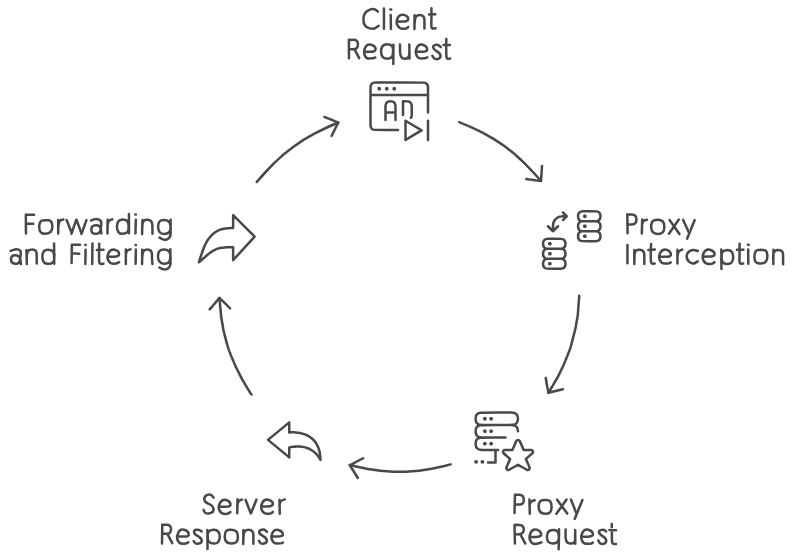Burp Suite is a powerful toolkit for web application security testing. One of its most essential features is the intercepting proxy, which gives you meticulous control over data flowing between your browser and web servers. Let’s explore how to use this capability of Burp Suite for intercepting web traffic with Burp Suite for in-depth analysis and manipulation of web requests and responses.
What is an Intercepting Proxy?
In the realm of web development, debugging, and security analysis, intercepting proxies serve as a crucial tool. They function as an intermediary between a user’s web browser and target web servers, providing unparalleled control over HTTP/HTTPS traffic.

Core Functionalities
- Comprehensive HTTP/S Traffic Monitoring: An intercepting proxy offers real-time, meticulous inspection of requests and responses. This includes:
- Request/Response Headers: Analysis of metadata essential for understanding communication behavior (user agents, session tokens, caching control, and more).
- URL Structure and Query Parameters: Dissection of resource paths and input parameters for vulnerability identification and application logic mapping.
- Request/Response Payloads: Examination of request bodies (form submissions, structured data formats) and server responses, facilitating content analysis and data manipulation.
- Precise Request and Response Modification: An intercepting proxy facilitates the alteration of network traffic flows for a variety of purposes:
- Header Manipulation: Modifications to test server expectations, simulate specific client conditions, or bypass potential restrictions.
- Parameter Adjustment: Changes to query strings and form data to probe input sanitization and identify potential injection points.
- Payload Crafting: Alteration of core request content to experiment with unexpected data types, lengths, or structures; crucial for security testing.
- Granular Traffic Control: Intercepting proxies provide fine-grained command over communication traffic:
- Interception and Analysis: Halt individual requests for examination, enabling developers or security testers to isolate and evaluate specific traffic details.
- Selective Dropping: Terminate requests to simulate failures or assess resilience mechanisms in a web application.
- Redirection: Divert traffic for troubleshooting, load balancing, or controlled testing across environments.
Primary Applications
- Web Application Security Testing: Intercepting proxies play a pivotal role in discovering vulnerabilities by meticulously controlling data sent to the server. This aids in the execution of attacks against:
- Injection Flaws (SQL, XSS, etc.)
- Broken Authentication or Session Management
- Insufficient Input Validation
- And countless other potential weaknesses
- Debugging and Network Analysis: Web developers utilize these proxies to investigate application behavior, pinpoint bottlenecks, and troubleshoot errors through a deep inspection of request-response cycles.
- Reverse Engineering and API Exploration: Developers and testers can gain deeper insights into how applications and APIs function by observing patterns and communication flow, potentially revealing undocumented features or behaviors.
- Content Filtering and Modification: Network administrators may leverage intercepting proxies to enforce usage policies, block prohibited content, or inject elements (watermarks, banners) for specific purposes.
Common Intercepting Proxy Tools
- Burp Suite Professional: Industry-leading toolkit favored by security professionals, offering a comprehensive suite of features for security testing and web application analysis.
- OWASP ZAP: Open-source web application security scanner, highly regarded for its flexibility and community support.
- Fiddler: Debugging proxy featuring an intuitive interface and robust capabilities, well-suited for web developers.
What is a Proxy Server?
Fundamentally, a proxy server acts as a middleman between your device (computer, phone, etc.) and the internet. Instead of your web requests going directly to the destination website, they first route through the proxy. This offers several benefits and use cases.

Key Types of Proxy Servers
- Forward Proxy: The most common type. Sits between your client device and the internet. Handles requests going outwards. Use cases include:
- Anonymity: Mask your true IP address, offering a degree of privacy.
- Bypass Restrictions: Access content blocked due to geographic location or network filters (schools, workplaces).
- Caching: Store frequent responses, leading to potential speed enhancements for subsequent requests.
- Reverse Proxy: Sits in front of web servers. Handles requests coming inwards. Primarily used by server admins for:
- Load Balancing: Efficient distribution of traffic across multiple servers to prevent overload.
- Security: An additional layer of defense against attacks, hiding the true origin of the servers.
- Web Acceleration: Caching, compressing content, and other techniques to optimize web page delivery.
Common Use Case Examples
- Accessing Geo-Blocked Content: Streaming services often enforce different content libraries based on location. A proxy in the appropriate country can enable you to bypass these restrictions.
- Corporate Networks: Organizations use forward proxies to enforce internet usage policies, monitor employee activity, and protect their networks from external threats.
- Web Scraping: If you need to gather data from multiple websites, proxies aid in rotating your IP addresses to prevent rate limiting or outright blocking by anti-scraping measures.
- Price Comparison: Some e-commerce sites might present different prices based on your perceived location. Using proxies from various locations can facilitate comparison shopping for finding the best deals.
How Proxy Servers Work (Simplified)

- Client Request: Your browser is configured to use a specific proxy server.
- Proxy Interception: The proxy server receives your web request.
- Proxy Request: The proxy makes its own request to the target website using its own IP address, essentially acting on your behalf.
- Server Response: The website sends the response back to the proxy server.
- Forwarding and Filtering: The proxy may filter, modify (rare), or simply forward the response back to you.
Additional Things to Note
- Transparency: Proxies vary in the level of anonymity they provide.
- Transparent proxies openly identify themselves as proxies.
- Anonymous proxies do not reveal they are proxies, making your traffic blend in more.
- Security: Not all proxies are secure. Always trust the source of your proxy server to avoid malicious activity or logging of your data.
- Speed Variations: Depending on proxy quality, location, and load, using a proxy may sometimes introduce latency (slower web experience).
Popular Proxy Services
- Residential Proxies: (e.g., Smartproxy, Bright Data), large pools of real user IP addresses, ideal for minimizing blocking risks when web scraping or needing high geographic specificity.
- Datacenter Proxies: Cheaper but more easily detected, generally well-suited for less sensitive tasks.
- Web-Based Proxies: Accessible directly in your browser, convenient but often slow and unreliable.
What is Burp Proxy
Burp Proxy is a core feature within the Burp Suite toolkit specifically designed for web application security testing. Let’s break down what it is and why security professionals love it:
Core Purpose: Man-in-the-Middle for Web Traffic

- Interception: Burp Proxy sits between your web browser and the target web application. This allows you to view all HTTP/HTTPS traffic passing between the two in real-time.
- Analysis: Analyze intercepted requests and responses in incredible detail. You’ll see headers, URL parameters, and the complete contents of form submissions and server responses. Perfect for understanding exactly how the application communicates.
- Modification: Burp Proxy isn’t just passive. You can alter any aspect of the captured traffic before forwarding it. This is the foundation for advanced security testing.
Key Use Cases for Burp Proxy
- Manual Security Testing:
- Vulnerability Discovery: Modify requests to probe for flaws like SQL injection, cross-site scripting (XSS), broken access controls, and more.
- Mapping Application Logic: Intercept traffic and study the flows to understand how an application functions, aiding in more focused test case design.
- Content Manipulation: Change content on the fly to assess server responses and potentially uncover hidden functionality.
- Debugging and Troubleshooting:
- Pinpoint Request/Response Issues: Deep inspection for diagnosing communication errors, performance problems, and unexpected server responses.
- Integration with Other Burp Suite Tools:
- Repeater: Send intercepted requests to Burp Repeater for repetitive testing with precise modifications to pinpoint and exploit vulnerabilities.
- Intruder: Use Burp Intruder to automate attacks that leverage captured traffic as templates for fuzzing and brute-forcing parameters.
- Scanner: Burp’s automated vulnerability scanner works together with the proxy to discover flaws on a broad scale.
Why it’s a Favorite Among Security Professionals
- Fine-Grained Control: Burp Proxy provides unparalleled control over request and response manipulation, crucial for crafting sophisticated tests.
- Extensibility: Supports custom plugins (called BApps) for integrating specialized tools and workflows.
- Ease of Use (relatively): While possessing a wealth of advanced features, Burp Proxy still boasts a reasonably intuitive interface relative to other professional security tools.
How to Get Started
- Download Burp Suite: Grab either the free Community Edition or Professional Edition from https://portswigger.net/burp
- Configure your browser: Adjust your browser settings to route traffic through Burp Proxy (usually, you set it up to listen on localhost, port 8080).
- Activate interception: Navigate to the “Proxy” tab within Burp Suite. Ensure “Intercept is on.”
- Experiment! Visit a website and watch requests appear in Burp. Analyze, modify, and forward them to begin your exploration.
Burp Proxy Configuration
Let’s focus on configuring and utilizing Burp Suite’s intercepting proxy, as it’s one of the most popular and powerful tools in this domain.

Prerequisites
- Download and install Burp Suite (Community Edition is free): https://portswigger.net/burp
- A modern web browser (Firefox and Chrome are ideal for smooth integration)
Part 1: Configuring Your Setup
- Burp Proxy Launch:
- Start Burp Suite and within the initial dashboard, you may temporarily use the default configuration and click “Start Burp.”

- Proxy Listener Setup:
- Navigate to the “Proxy” tab -> “Options” tab.
- You should see an existing “Proxy Listener” running – usually on localhost, port 8080. This is where Burp will listen for traffic. Note the port number.

- Browser Configuration:
- Firefox:
- Preferences -> Network Settings -> Settings
- Select “Manual proxy configuration”
- Set “HTTP Proxy” to “localhost” and the “Port” to your Burp listener port (e.g., 8080)
- Tick “Use this proxy server for all protocols”
- Chrome:
- Settings -> System -> Open your computer’s proxy settings
- Follow platform-specific configuration (it should mirror Firefox’s settings)
- Firefox:
Part 2: Intercepting and Analyzing Traffic
- Intercept Activation:
- In the “Proxy” tab -> “Intercept” sub-tab, ensure “Intercept is on.”

- Test Browsing:
- In your configured browser, visit any website (e.g., http://example.com).
- The HTTP request should be paused within Burp’s “Intercept” tab.

- Request Analysis:
- Examine the captured request:
- HTTP Method (GET, POST, etc.)
- Target URL and parameters
- Headers (Referer, Cookie, User-Agent, etc.)
- Request Body (especially data in forms or structured formats like JSON)
- Examine the captured request:

- Modification (Optional):
- Burp allows changing any element of the request. Exercise caution due to potential unintended side effects on the application.
- Forwarding/Dropping:
- Click “Forward” to send the (potentially modified) request to the server.
- Click “Drop” to halt the request entirely.
- Response Analysis:
- After forwarding, the target web server’s response will be captured in Burp. Evaluate it similarly to the request phase.

Part 3: Utilizing Burp Repeater

- Sending to Repeater:
- Right-click anywhere in the intercepted request/response area.
- Select “Send to Repeater.”
- Repeater Tab:
- Navigate to the “Repeater” tab in Burp Suite. You’ll see your request.
- Manipulation and Re-Issuing:
- Freely modify any part of the request (headers, parameters, methods, etc.)
- Hit “Go” to resend the modified request. The response will appear alongside.
- Experiment! Change variables, introduce unexpected input, and observe how the server reacts.
Example Use Case: Testing Input Validation
- Identify an input field in a web form (login, search box, etc.).
- Intercept a request containing that input.
- Send the request to Repeater.
- Experiment with the input:
- Try extremely long strings
- Inject special characters (<, >, “, ‘, etc.)
- Test unexpected data types (numbers in a text field)
- Carefully examine responses for anomalies in the application’s behavior or error messages.
Advanced Burp Features (Brief Overview)
- Scanner: Automate discovery of vulnerabilities within applications.
- Intruder: Attack tool for brute forcing, parameter fuzzing, and custom payloads.
- Target Scope: Precisely define what traffic Burp should focus on.
- And many more!







